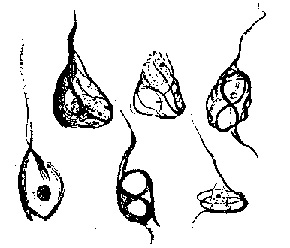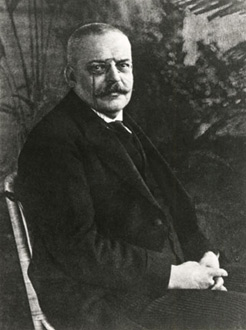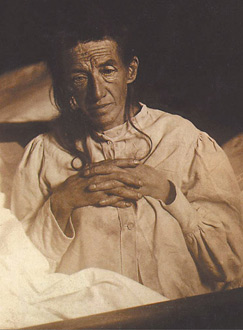History Module: Dr. Alois Alzheimer’s First Cases
Alois Alzheimer | In November 1901, Dr. Alois Alzheimer, a German neurologist, made his first examination of a 51-year-old woman named Auguste Deter who was experiencing problems with memory and language as well as various psychological problems such as disorientation and hallucinations. These symptoms matched the definition of what was then called dementia, but she was very young to be displaying them, so he diagnosed her as having “presenile dementia”. |
Auguste Deter died on April 8, 1906. Since Dr. Alzheimer had never seen another case like hers, he obtained her family’s permission to perform an autopsy on her brain. When he examined it, he observed extensive atrophy, especially in the cortex—the thin outer layer of grey matter that is involved in memory, language, judgment, and thought in general. When Dr. Alzheimer sampled thin slices of this brain tissue, stained them with silver salts, and examined them under the microscope, he observed two types of abnormal deposits inside and in between the nerve cells. Other scientists had already observed such deposits, but this was the first time they had ever been observed in anyone so young. |
Auguste Deter |
On November 4, 1906, at the 37th annual conference of German psychiatrists, in Tübingen, Germany, Alzheimer described for the first time the “particular malady of the cerebral cortex” of his patient Auguste Deter. The following year, he published this presentation as an article, but only in 1911 did he publish a more detailed article interpreting his observations. In this article, he described the cases of Johann F. and a number of other patients with what had already come to be known as “Alzheimer’s disease”. The suggestion that Alzheimer’s name be given to this syndrome came not from Alzheimer himself, but from his boss, Emil Kraepelin, at the laboratory in Munich that had recruited Alzheimer a few years earlier. Regarded by many as the founder of scientific psychiatry, Kraepelin include a description of the case of Auguste Deter in the 8th edition of his book Psychiatrie, published in 1910. Some scientists, including Alzheimer himself, were somewhat surprised at how quick Kraepelin had been to recognize and name this condition as a distinctive disease. One explanation offered was that the prestige associated with this discovery inevitably reflected well on Kraepelin’s laboratory and helped him secure more funding for his research. |
 Sketch of neurofibrillary tangles in the brain of patient Auguste D., from the 1911 article by Alois Alzheimer |
Be that as it may, more and more cases like those of Auguste D. and Johann F. were soon reported and associated with Alzheimer’s name. The case of Johann F. was especially interesting, because his symptoms, including major memory problems along with language, movement, and other impairments, appeared when he was only 54 years old. Intriguingly, whereas the autopsy of Auguste D.’s brain had shown two kinds of deposits—one outside the nerve cells (in modern terminology, “amyloid plaques"), the other inside (now known as “neurofibrillary tangles"), the autopsy of Johann F’s brain revealed the presence of the external deposits only. This observation was confirmed in the late 1990s when a research team found intact sections of Johann F’s brain tissue in the archives of the University of Munich’s Institute of Neuropathology. |
Thus, almost immediately after two of the main physical signs of Alzheimer’s were discovered, scientists began to observe less typical cases that revealed how complex a phenomenon it actually was. On December 19, 1915, five years after Kraepelin’s book was published, Alois Alzheimer died prematurely at the age of 51 as the result of heart and kidney problems. Disdained for much of his lifetime as “only an anatomist", he is now well recognized for his contribution to modern neuropathology. His greatest success was to have correlated his anatomical findings with his clinical observations, something not at all common at the time. |
|
|


